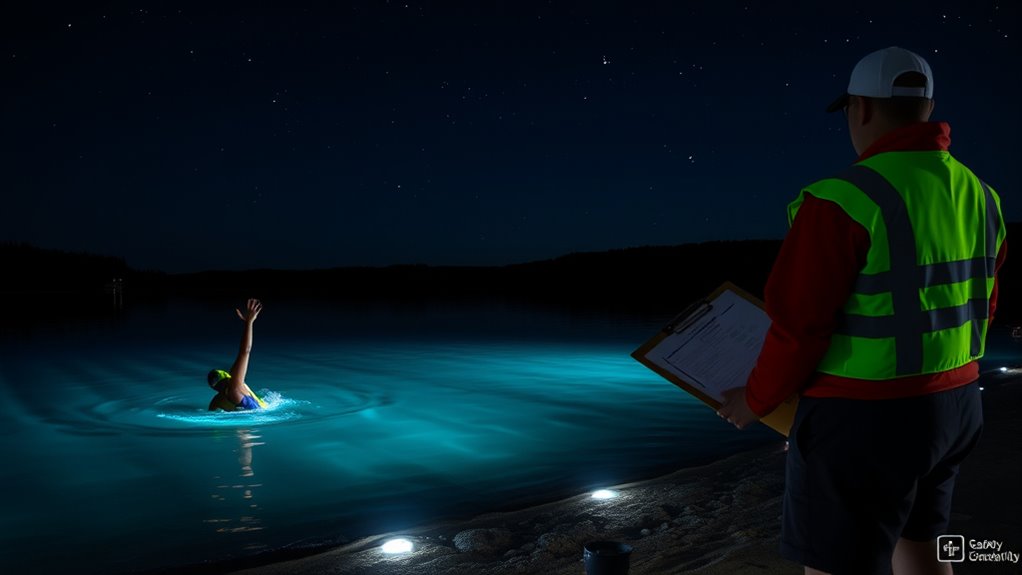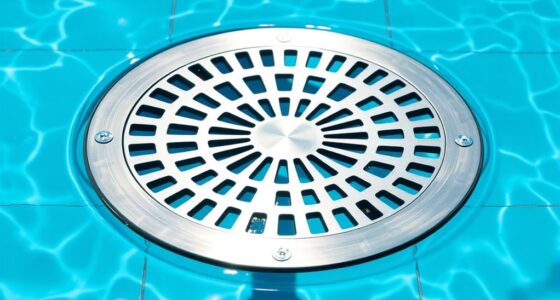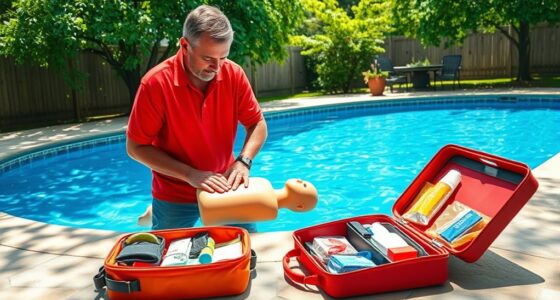When night swimming, always go with a buddy and let someone know your plans. Check water conditions and stick to designated areas to stay safe. Use waterproof lights and underwater LEDs for clear visibility, and make certain all equipment works properly. Limit splashing to avoid startling others and watch out for rocks or obstacles. For better safety, follow local regulations and consider advanced lighting or automation systems. Keep exploring to discover even more safety tips you’ll want to know.
Key Takeaways
- Always swim with a buddy and inform someone of your plans and estimated return time.
- Carry waterproof, rechargeable lights and position them to reduce shadows and glare for better visibility.
- Check water conditions and avoid swimming in rough, unpredictable, or unfamiliar areas at night.
- Use underwater lights and ensure all lighting equipment is waterproof and functioning properly.
- Follow local regulations, stay close to the shore, and be aware of underwater hazards to ensure safety.
Essential Safety Precautions for Night Swimming

Night swimming can be enjoyable, but it also requires extra safety measures to prevent accidents. Always swim with a buddy; never go alone, especially after sunset. Inform someone on land about your plans and estimated return time. Check the water conditions beforehand—avoid swimming in rough or unpredictable water. Use a personal safety flotation device if you’re not a confident swimmer. Keep your movements deliberate and avoid splashing or making loud noises that could startle others or attract unwanted attention. Stay close to the shore or designated swimming areas to prevent drifting into dangerous zones. Remember, visibility is limited, so be extra cautious around rocks, underwater obstacles, or sudden drop-offs. Being aware of local regulations can help ensure you’re following safety guidelines and avoid penalties. Carry a reliable night swimming light to enhance visibility and safety in low-light conditions. Proper lighting not only improves your ability to see but also makes you more visible to others, reducing risks during night swims. Additionally, choosing well-lit areas can significantly increase safety during night swimming activities. Remember to check your equipment regularly for proper functioning, especially your lighting and flotation devices. Prioritize safety, and you’ll enjoy a secure night swim.
Effective Lighting Strategies for Night Water Activities

Effective lighting is essential for staying safe during water activities after dark. You need to guarantee the area is well-lit, so you can see clearly and avoid hazards. Use waterproof floodlights or submersible LED lights around the pool or shoreline to illuminate your surroundings. Portable, rechargeable lights are convenient for added mobility. Position lights to minimize shadows and glare, providing consistent visibility across the area. Avoid relying solely on ambient or distant lighting, which can create dark spots. Consider installing underwater lights for better visibility beneath the surface. Always check that your lighting equipment is waterproof and in good working condition before heading out. Proper illumination helps you spot obstacles, other swimmers, and changes in water conditions, keeping everyone safer. Additionally, understanding the importance of contrast ratio can help you select brighter, more effective lighting setups that improve overall visibility in dark environments. Incorporating AI-driven lighting controls can further optimize your setup by automatically adjusting brightness based on ambient conditions, enhancing safety and efficiency. Advances in robotic technology are increasingly being used to automate lighting adjustments and maintenance, ensuring consistent safety measures. Research shows that security measures like proper lighting significantly reduce the risk of accidents and unauthorized access during night water activities. Being aware of personality traits related to water safety can also promote better decision-making and risk management during night swimming.
Frequently Asked Questions
What Should I Do if I Get Lost at Night in the Water?
If you get lost at night in the water, stay calm and try to signal for help by waving your arms or calling out. Keep your head above water to breathe easily and conserve energy. If possible, look for familiar landmarks or shoreline to guide you. Use your flashlight or any reflective object to attract attention. Remember, staying calm and conserving energy increases your chances of rescue.
How Can I Signal for Help Effectively During Night Swimming?
When you need to signal for help during night swimming, stay calm and use clear signals. Wave your arms or splash loudly to attract attention. If you have a whistle or waterproof signaling device, blow it repeatedly. Shine a flashlight or glow sticks toward rescuers or boats. Make eye contact and keep your movements deliberate. Remember, staying visible and making noise increases your chances of being noticed quickly and getting assistance.
Are There Specific Clothing or Gear Recommended for Night Swimming Safety?
You might think special gear isn’t necessary, but wearing reflective or brightly colored clothing makes you more visible to others, especially in low light. Consider carrying a waterproof flashlight or glow sticks to signal for help if needed. Wearing a whistle can also be a lifesaver. Don’t underestimate the importance of these items—they guarantee you’re safer and easier to locate during night swims, giving you peace of mind.
How Do Weather Changes Affect Night Swimming Safety?
Weather changes can considerably impact your safety during night swimming. Sudden storms or rain can create slippery surfaces and reduce visibility, increasing the risk of accidents. Cold weather lowers water temperature, risking hypothermia, while wind can stir up waves, making swimming more difficult. Always check the weather forecast before you swim, avoid swimming during storms or high winds, and be prepared to exit quickly if conditions worsen.
What Are the Best Emergency Contacts to Have on Hand?
Imagine having a safety net ready just in case. You should keep emergency contacts like local emergency services, your trusted lifeguard, and a nearby hospital’s number handy. Also, include a friend or family member who can assist quickly if needed. Save these contacts in your phone with clear labels, so you’re prepared without hesitation. Being organized guarantees help is just a call away, making your night swim safer and more enjoyable.
Conclusion
Remember, as if you’re steering the mysterious depths of the night like a seasoned sailor, safety and proper lighting are your guiding stars. By following these precautions, you’ll guarantee your night swimming adventure remains a thrilling yet safe experience. Embrace the allure of moonlit waters with confidence, knowing you’ve prepared wisely. Stay vigilant, light your way, and let the ocean’s secrets stay enchanting—not dangerous. Immerse yourself, but do so with care and clarity.









